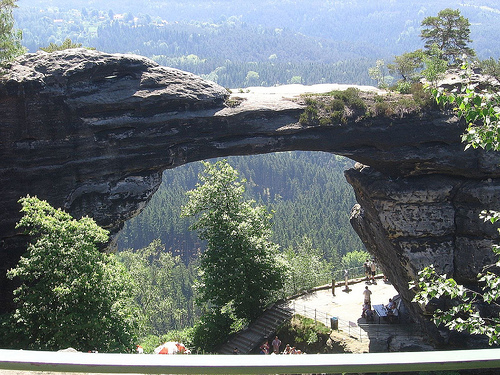

Location: North Bohemia Map
Area: 79 km²
Official site
Pravčická gate
Open: Apr- Oct: 10am- 6pm
Entrance fee: 75 CZK for adults
25 CZK for children (6- 14 years)
Ceske Svycarsko National Park is
situated in North Bohemia of the Czech Republic. Its name is translated as
Czech Switzerland for its picturesque landscapes, dense forests and
beautiful geological formations. Ceske Svycarsko National Park
covers an area of 79 km². One of its most
famous and most visited sites is a Pravčická gate. At 16 meters high
and 16.5 meters wide it is the largest natural rock arch in Europe. It is
prohibited it climb the formation. Although it might appear sturdy and
permanent it is not. Pravčická gate is composed of sandstone left from the
time of Mesozoic era then dinosaurs roamed the planet. Age takes a toll on
this natural marvel. Erosion have caused parts of the Pravcicka bridge to
collapse so climbing this geological formation is very dangerous and
ultimately stupid. Falcon's nest lodge is that situated near the arch was
built in 1826 and served as a tavern. Today it houses a museum of Bohemian
Switzerland and a restaurant.
Other popular destinations in the Bohemian Switzerland
include valleys of Kamenice and Krinice rivers, tributaries of the Elbe
river. České Švýcarsko National Park has a continuation on the German side of the border
known as
Saxon Switzerland National Park. In case you were curious what genius
came up with these "original" names look no further. Swiss painters Adrian
Zingg and Anton Graff who worked for the Academy in Dresden often came to
the valley of the Elbe river. Since they liked so much, they called the
region after their homeland.
The term Bohemian Switzerland was created based on the name Saxon
Switzerland of the German part of the Elbe Sandstone Mountains in the
18th century and is said to go back to the two Swiss artists Adrian
Zingg and Anton Graff, who may have felt reminded of their homeland by
the landscape.
In the Czech Republic, the terms Děčínská vrchovina
(official geomorphological name, German for example Tetschener Bergland)
and Labské pískovce (Elbe Sandstone Mountains), which are essentially
synonymous, also exist for the region.
In contrast to neighboring Saxon Switzerland, Bohemian Switzerland is
not characterized by mountains towering over the landscape. Exceptions
are the table mountain Hoher Schneeberg (Děčínský Sněžník) and the
basalt crest of the Rosenberg (Růžovský vrch).
The landscape is
divided into two parts by the Elbe Gorge, which is lined with steep,
high cliffs. On the right side of the Elbe, the flat, undulating,
agricultural cultural landscape - the flatness - spreads out, which is
dominated by the Rosenberg. North of it are the rocky areas divided by
gorges and the steep rock faces on the south side of the Winterberg
(Prebischtor area). To the left of the Elbe, this wavy landscape is
densely wooded, in the area of the transition to the Ore Mountains there
is the highest mountain in the Elbe Sandstone Mountains, the Hoher
Schneeberg. As in the adjacent Ore Mountains, the landscape there drops
steeply to the south.
In the area of Bohemian Switzerland there are a number of castle
complexes protecting trade routes. Some of the castles were also used as
medieval robbery nests. In prehistoric times, this area was sparsely
populated by Celtic, Germanic and later Slavic tribes and was only
colonized by German-speaking settlers in the 12th century. Until the end
of World War II it was inhabited by German Bohemians. Since the
expulsion of the German population after 1945, this area has been
populated almost exclusively by Czechs.
The development of
tourism in the Elbe Sandstone Mountains only began in the 19th century.
Romantic artists were inspired by the wild beauty of the rocks, such as
the painter Ludwig Richter or the composer Carl Maria von Weber, who set
his famous opera Der Freischütz near Rathen.
Starting from Saxon Switzerland, the rocks in the Bohemian part of
the Elbe Sandstone Mountains finally came into view of the mountaineers.
The first climbing peak in Bohemian Switzerland was opened in 1888 with
the Beckstein in the Prebischtor area. The most important climbing
peaks, all of which were first climbed before the First World War, are:
Großer Prebischkegel, Nonne, Doggenturm, Empor Nadel, Wotanskegel and
Kastenturm. The development was mainly carried out by German climbers
from Dresden and Tetschen-Bodenbach.
After the Second World War,
the area was then systematically developed, primarily by Czech climbers
(e.g. Karel Bělina, the Weingartl brothers). From the mid-1960s, German
climbers from Dresden were again instrumental in further development. In
the 1970s, the remaining climbing targets located in the former border
restricted area were opened up again.
After the establishment of
the Bohemian Switzerland National Park, serious restrictions came into
force for mountain sports. At first, climbing was completely forbidden,
as in all Czech national parks, but later a regulation was made that
allowed climbing at certain times of the year.
Prebischtor, the largest natural sandstone rock bridge in Europe
Edmundsklamm and Stille Klamm, a rocky gorge near Hřensko
Tyssa
Walls, a rock labyrinth
Děčínský Sněžník, the highest mountain in
Bohemian Switzerland with a lookout tower
Rock castle Schauenstein,
robbed castle near Vysoká Lipa
Marienfels, vantage point near
Jetřichovice
Wilhelminenwand, vantage point near Jetřichovice
Rudolfstein, vantage point near Jetřichovice
Paulinengrund (Czech:
Pavlino Udoli), a deeply incised romantic rocky valley crossed by the
Kreibitzbach (Chribská Kamenice).
Rock Castle Falkenstein
Rock
chapel in Všemily
Belvedere near Labská Stráň
Small Prebischtor
Balzhütte (Czech: Na Tokani)
View of the Emperor from the Quaderberg
near Děčín
Lookout tower on Janovsky vrch near Janov u Hřenska
the
well-maintained villages with their half-timbered houses